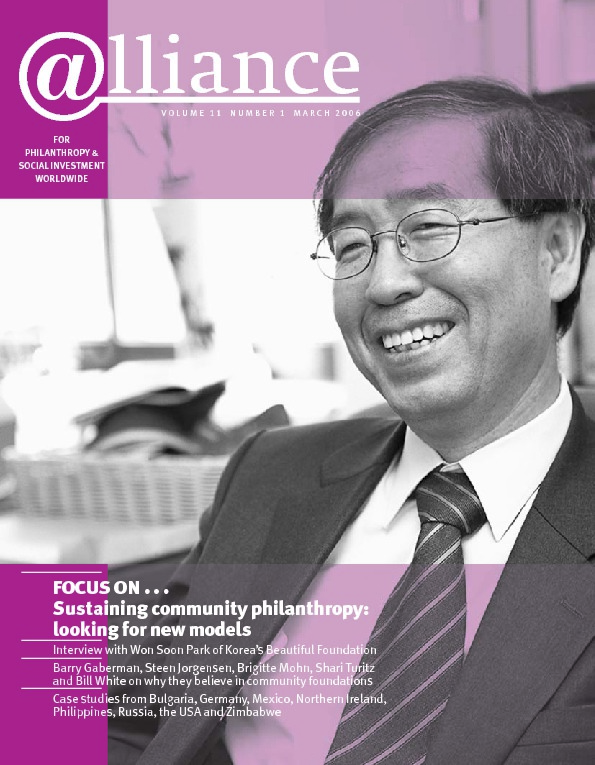Over the past ten years, public awareness of the scale of women’s human rights violations worldwide has grown considerably but funding for women’s organizations to protect and guarantee these rights has not.
In 2005, the Association for Women’s Rights in Development (AWID), an international membership organization of thousands of gender equality advocates, set out to determine whether funding for women’s rights was actually shrinking and, if so, why. Secondly, and more positively, we wanted to find out what opportunities exist to increase the amount of funding for women’s organizations globally and to improve access to it.
The research found the current state of women’s rights organizations to be one of ‘survival and resistance’. Of hundreds of organizations globally that participated in a quantitative survey, over half are receiving less funding now than they were five years ago. We were surprised too to find that women’s organizations are, financially, small players in civil society, with the majority having annual expenses well below US$100,000. Similarly, groups spend more time on fundraising now than in past years, with many having to present proposals for activities that ‘fit’ with the agenda of the funder rather than a more political agenda for justice, accountability and transformation.
Changes in funder attitudes
Our research uncovered a number of reasons to explain this downward trend. The most prominent supporters of women’s rights groups have traditionally been development aid agencies, large independent foundations and international NGOs. Bilateral and multilateral aid agencies that were once the strongest supporters of women’s rights organizations are cutting back their levels of funding and directing more funds through national governments rather than to NGOs. Many of these funding agencies have good gender equality policies, but they don’t translate into practice for women’s rights on the ground. And with growing conservatism in many donor countries, gender equality advocates within these agencies say they face an uphill battle to continue ‘making the case for gender equality’.
Among large independent foundations, changes in leadership have led a handful of major foundations to move away from supporting women’s movements. This has been in part due to a visible shift towards ‘impact and efficiency’, which leads foundations to narrow their focus and provide larger grants to fewer, larger organizations. There has also been a backlash among some towards ‘feminism’.
Furthermore, international NGOs often struggle with their dual identities as donors and as NGOs with their own advocacy agendas. Some position themselves as strong supporters of women’s rights, yet there can be considerable tensions with existing women’s rights groups as they can appear more as competitors than as supporters and collaborators.
The opportunities
In what is easy to cast as a bleak landscape, there are important opportunities. Many long-time supporters of women’s rights and gender equality – especially development assistance agencies and international NGOs – are revisiting their strategies and realizing that they need stronger connections and better partnerships with women’s movements and organizations. New governments coming onto the funding scene – from Spain to Korea – could, with some investment and collaboration, become important supporters of women’s rights groups. Similarly, corporate foundations, family foundations and individual donors are an important growing source of funding for women’s rights groups to tap. Meanwhile, over the last ten years, women’s funds have also been blossoming. In fact, even though they give grants of just $5,000-10,000, they were cited as the recent number one source of funding by our survey respondents.
FundHer
Building on these research results, AWID and partners have set out to do two main things: first, engage the donors through dialogue and advocacy to leverage more funds for women’s rights work and women’s organizations; second, support women’s organizations globally to raise more funds, absorb them effectively, and show their impact on gender equality.
In particular, we have set up an initiative known as ‘FundHer – Money Watch for Women’s Rights’, to monitor amounts of funding going to women’s organizations and women’s rights work as well as to work to influence key institutions to increase the accessibility and size of these funds. AWID will work with strategic partners to put pressure on donor governments to allocate at least 1 per cent of their annual development aid for direct support for women’s organizations and networks. Similarly, international NGOs will be encouraged to increase their support for women’s rights organizations – allocating, for instance, 30 per cent of their funding to this purpose. At the same time, we will also work closely with women’s organizations to increase absorption capacity and effectiveness through research, dialogue and capacity-building.
At the end of the day, AWID is certain that without strong, vital and effective women’s organizations and networks all over the world, existing women’s rights achievements could be lost. More to the point, without strong women’s organizations, very little headway will be made on any of the major global agendas for peace, eradication of poverty or children’s rights, to name a few, that crucially depend on women’s empowerment.
The full 115 page draft report, written by Cindy Clark, Lisa VeneKlasen and Ellen Sprenger of Just Associates with Joanna Kerr and Lydia Alpizar of AWID, was launched at AWID’s International Forum in Bangkok in October 2005. The report is now available at http://www.awid.org, or contact AWID at awid@awid.org to receive a copy by post.
Joanna Kerr is Executive Director of AWID. She can be contacted at jkerr@awid.org
To download the full report, visit http://www.awid.org



Comments (0)